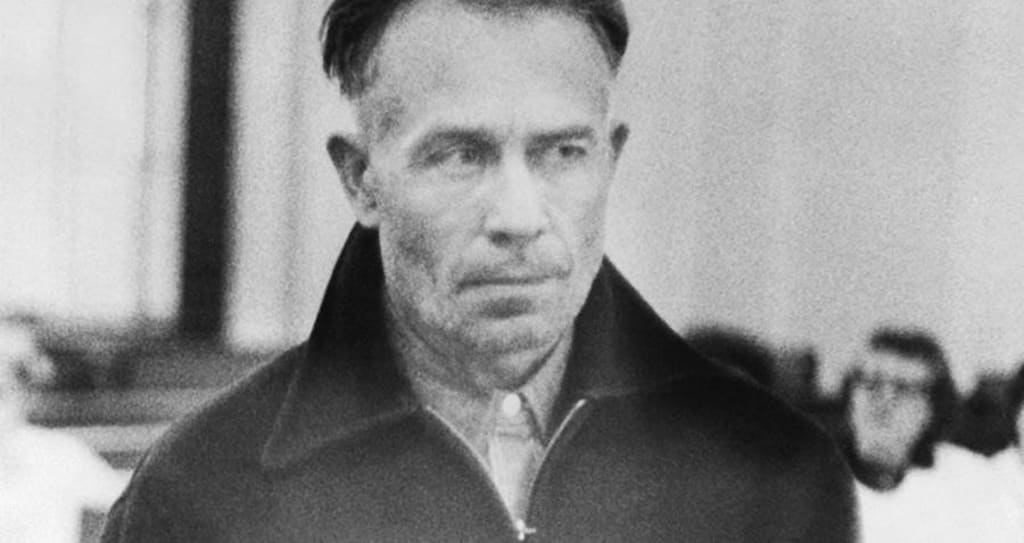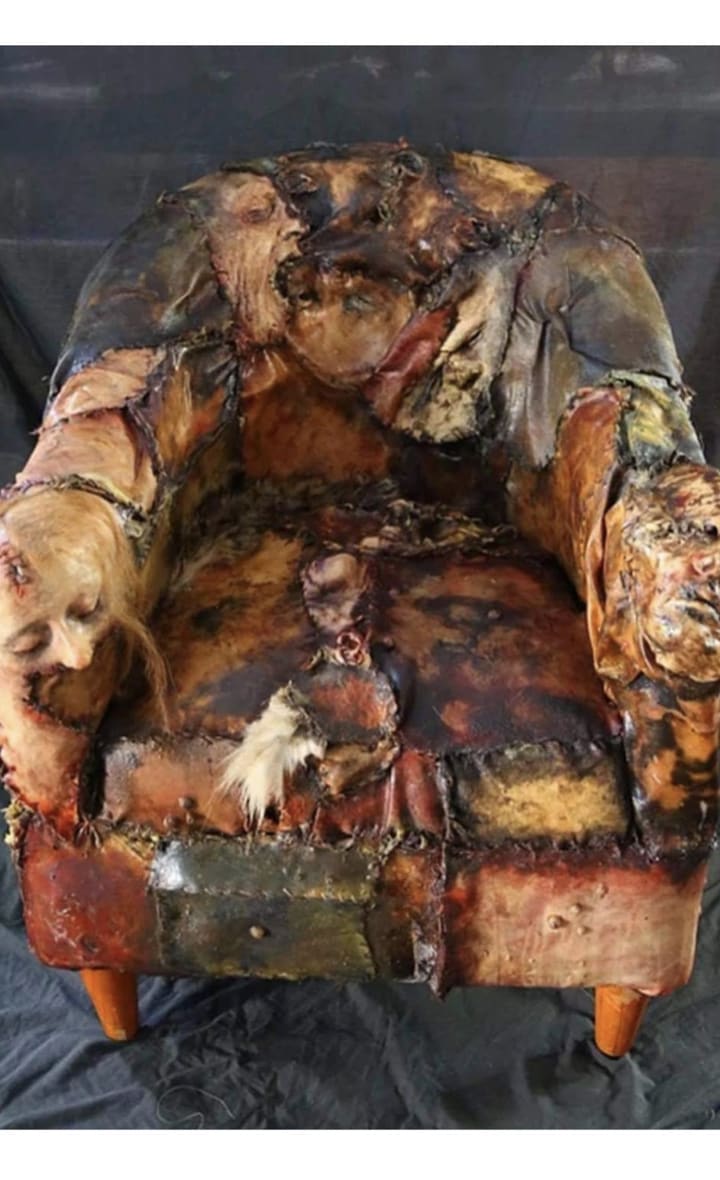When Art Mimics Real Life
And Facts are scarier than fiction

The Butcher of Plainfield, a small towns horror and grisly secrets:
Movies sure have a way of getting under our skin. This man’s crime is the basis of many of the movies that have your skin crawling.
What is worse than a movie with a good jump scare, and psychological thriller that messes with your mind? One based off the true stories of a family and small town in torment.
It’s been said that every murderer is relatively sadistic and cruel, void of feeling or remorse. However, there is one that was so bad he served as the inspiration for some of Hollywood’s most sadistic murder movies.
Ed Gein: picture
His name: Ed Gein: AKA (Buffalo Bill, Norman Bates, and Leatherface.) were the inspiration behind many horror characters you have come to know and fear.
Psycho:
The early years:
Ed Gein, Butcher of Plainfield, or the Plainfield Ghoul, was an American convicted murderer and body snatcher. He was always a little bit off, according to accounts of his classmates and family. How off, had yet to be seen.
His teachers and classmates at his elementary school recall him being shy. Although they pointed out that he had strange mannerisms, and sudden bursts into fits of laughter and anger, that made him stand out. No one knew what would set him off, he apparently would laugh and scream and carrying on conversations with himself. His school blamed his mother, who punished him when he tried to make friends.
Not only did his mother punish him and discourage Ed physically from expanding his social life, she would keep Ed and his brother Henry confined to their farm. She would punish the boys harshly if they disobeyed or left her sight without her permission. She would read to them from the Bible, and preach that the world was inherently evil, that all women were prostitutes, and that drinking, and immorality were instruments of the devil. She was increasingly aggressive as the boys got older and regularly beat them.
It is speculated, for the most part, his childhood was relatively solitary. It would also set the tone for the anger, confinement and terror he would unveil, as he began his gruesome existence.

Curiosity-seekers peer through a window into the house of serial killer Edward Gein, Plainfield, Wisconsin, November 1957.
( The bright lighting in the side ground floor window is part of the illumination for the on-site crime lab.)
First suspicions of murder:
When Gein was 38 years old, he and Henry, his brother, were working in the fields on their farm, burning marsh vegetation. The fire got out of hand and spread; the neighbors alerted the fire department. After the firefighters had come and gone, and the fire was dealt with, Ed reported his brother missing.
Later that night, his body was found face down in the marsh, from assumed asphyxiation. Though authorities soon realized that Henry had been beaten and was most likely dead before the fire. The noted that later, they found he had bruises all about his head.
Authorities suspected that Ed had killed his brother, though there wasn’t sufficient evidence to prove it, so they were forced to accept that his death had been an accident. Later, investigators would claim that there was no doubt that Ed had been the murderer.

The interior of Edward Gein’s home, in a state of disrepair.
The beginning of his mental unraveling:
After his brother’s death and his mother’s a few years after that, Gein renovated his farmhouse. However, rather than turning it into a home for one, he boarded up every room that had been used by his mother and moved into a single bedroom off the kitchen.
While the boarded-up parts of the house remained pristine, the rest of the rooms became deteriorated, as Gein was lazy and didn’t care about upkeep. Some speculate it was due of his mother’s constant abuse and slave-like labor she put on the boys.
While living in seclusion on his farm, Gein became interested in death-cult magazines, and Nazi-cannibal-adventure stories. However, as decrepit as he had become, he mostly kept to himself. And he began to get lonely and his thoughts festered.
Terror and gore, give way to the light:
In November of 1957, a local hardware store owner disappeared.
Bernice Worden had last been seen the previous night and after her hardware store remained closed all day, was reported as missing. Her son Frank, who happened to be the deputy sheriff, entered the store to investigate, and discovered the cash register open and bloodstains on the floor.
While being interviewed, Frank and investigators found out that Gein had been in the store the night before and had told Worden he would be back in the morning for a gallon of antifreeze.
Sure enough, the last sale made at the store by Bernice Worden was for a gallon of antifreeze. Investigators headed to Ed Gein’s home, arresting him, and searching the property.
There was no way to be prepared:

Trooper Dave Sharkey looks over some of the musical instruments found in the home of Edward Gein, 51, suspected grave robber and murderer.
Grisly Discoveries at Edward Gein’s House
Also found in the house were human skulls, heads, death masks and the newly butchered corpse of a neighbor woman. January 19, 1957.
They had been prepared to find Bernice Worden’s body on the farm. However, nothing could prepare the police for what was inside.
While searching the house, authorities found what would later inspire horror movies such as Silence of the Lambs, Psycho, and The Texas Chainsaw Massacre.
Ed Gein’s home was filled with human body parts.
There were countless bones, both whole and fragmented, skulls impaled on his bedposts, and bowls and kitchen utensils made from skulls. Worse than the bones, however, were the household items made from human skin.

Edward Gein’s chair upholstered in human skin.


Authorities found chairs upholstered in human skin, a wastebasket made of skin, leggings made from human leg skin, masks made from faces, a belt made of nipples, a pair of lips being used as a window shade drawstring, a corset made of a female torso, and a lampshade made from a human face.
Along with the skin items, police found various dismembered body parts, including fingernails, four noses, and the genitals of nine different women.
Bernice Worden’s body was found as well, decapitated. Her head had been hung in a burlap sack, and her heart was hanging in a plastic bag near the stove. Her body had been strung up, upside down, and gutted like a deer.
Police also found the remains of another woman, Mary Hogan, equally as dismembered.
When questioned, Ed Gein folded immediately. He told police that he had made at least 40 different visits to the three local graveyards to exhume bodies. He claimed that he had done so in a daze-like state. Authorities discovered he had exhumed corpses from local graveyards and fashioned trophies and keepsakes from their bones and skin.
Gein also confessed to killing tavern owner Mary Hogan 1954, and eventually admitted his guilt of hardware store owner Bernice Worden 1957.
Methods and motives:
In addition to his methods, Gein also revealed his motives. He told authorities that soon after his mother’s death, he had begun to create a “woman suit” so that he could literally become his mother, and crawl into her skin. Since he had no outside connections and his social skills had been stunted by his mother, he found it comforting.
Though there were parts of countless bodies found in his home, Gein was arraigned on only one count of murder: Bernice Worden’s.
Ed Gein pleaded not guilty by reason of insanity and was declared unfit to stand trial. He was sent to the Central State Hospital for the Criminally Insane, where he was diagnosed with schizophrenia.
1968, he was judged competent to stand trial; he was found guilty of the murder of Worden, but he was found legally insane and was remanded to a psychiatric institution.
He died at Mendota Mental Health Institute of respiratory failure, on July 26, 1984, aged 77.
He is buried next to his family in the Plainfield Cemetery, in a now-unmarked grave.
Information referenced from the following:
. By All That's Interesting
Published November 9, 2017
Updated May 17, 20
https://en.wikipedia.org/wiki/Ed_Gein
John Philip Jenkins
Distinguished Professor of History, Baylor University. Author of A History of the United States, Mystics and Messiahs: Cults and New Religions in America, Synthetic Panics: The Symbolic..
About the Creator
Kelli Sheckler-Amsden
Telling stories my heart needs to tell <3 life is a journey, not a competition
If you like what you read, feel free to leave a tip, I would love some feedback
Find me on twitter @kelli7958958
or facebook
Enjoyed the story? Support the Creator.
Subscribe for free to receive all their stories in your feed. You could also pledge your support or give them a one-off tip, letting them know you appreciate their work.






Comments
There are no comments for this story
Be the first to respond and start the conversation.